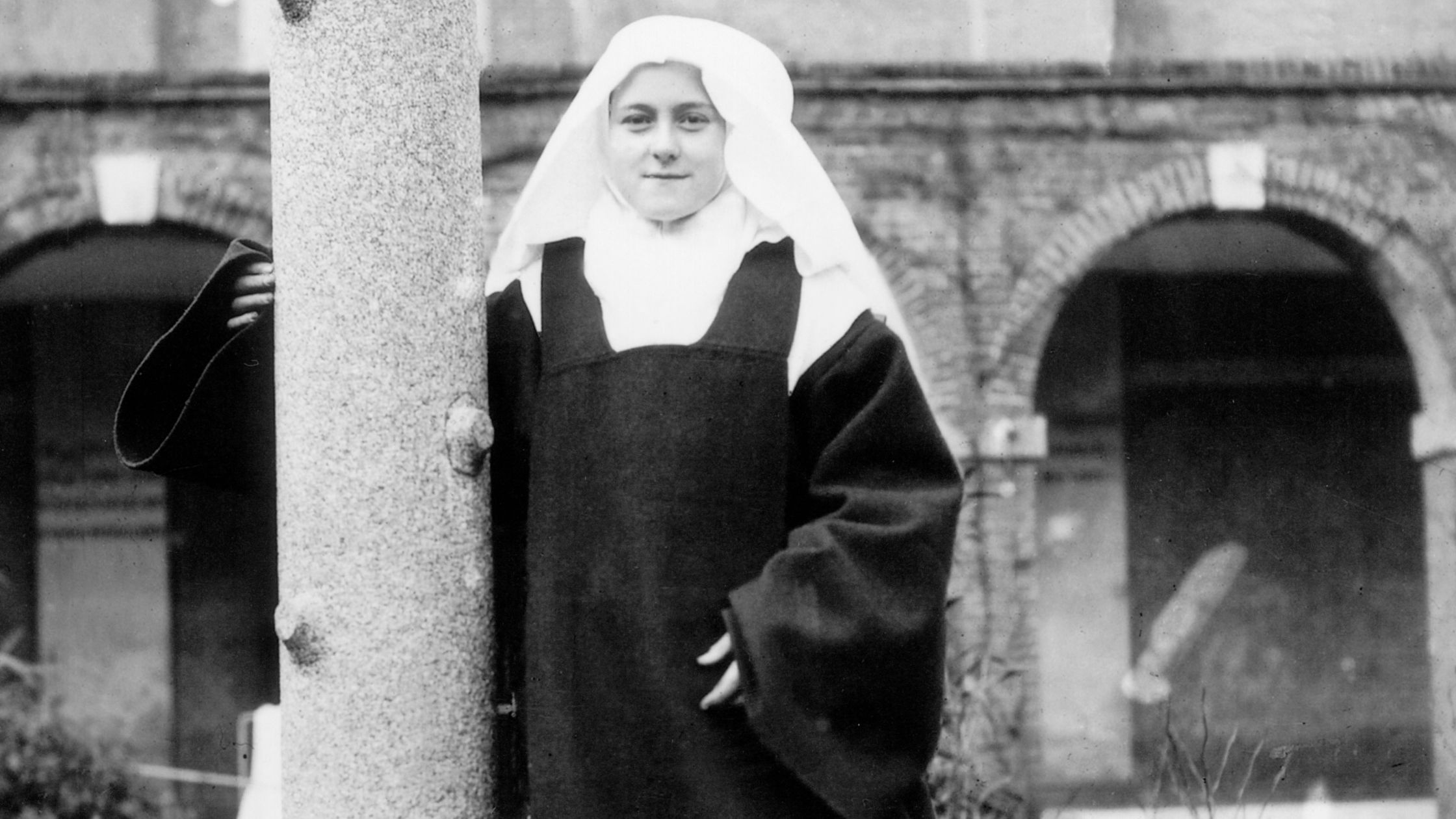With extracts from our book Thérèse of Lisieux: Transformation into Love, discover ten things you may not know about the saint fondly known as the Little Flower.
1. Thérèse was the odd one out at school
“More change came when she was eight and a half years old and joined [her sister] Céline as a day girl at the Benedictine Abbey school, where her mother’s older sister, Sr orothea, was a nun. Thérèse said that if it had not been for Céline’s presence, she would not have lasted the five years she was there. [Her oldest sisters] Marie and Pauline had already been giving her lessons, and she was ahead of all the other girls in her class, but she had not been prepared for the rough and tumble of school. She didn’t know how to play the playground games; she was the odd one out and she could respond to her classmates’ teasing only with tears. There was a girl in her class, not too bright but who had a way of influencing the other girls and even the teachers. She was so jealous of Thérèse always coming top in class that she seemed to have a thousand ways of making her unhappy. But a further trial awaited Thérèse.”
2. She enjoyed playing “hermits” with her cousin
“Thérèse preferred playing at being a hermit with her cousin Marie Guérin to joining in with what she considered the childish games of the other children at school. The two cousins even tried playing “hermits” when walking with their eyes closed along the street – until they bumped into some display boxes outside a shop, tipping them over. They hurried away, trying to maintain their dignity, while the reproaches of the angry shopkeeper followed them.
3. One of the hardest parts of entering Carmel was telling her father
“Carmel’s call was now so strong that Thérèse said that if she had been forced to pass through flames, she would have done it out of love for Jesus.11 The hardest test was to tell her father of her decision. She waited until the feast of Pentecost and sought him out in the quiet of the garden. With tears in her eyes, she spoke of her call to Carmel, and her father’s only response was that she was a little young to enter just yet. But Thérèse defended herself and her fixed resolve won over her father. He accepted her decision with the generosity and even the joy of a saint, according to Thérèse.
“As they were walking along, her father bent down and plucked a white lily-like flower with its roots attached and gave it to her. For Thérèse, it represented her destiny to be rooted in other soil. She placed it in her copy of Thomas à Kempis’s The Imitation of Christ, at the chapter entitled “One must love Jesus above all things” (she knew whole chapters of The Imitation by heart).”
4. She entered Carmel committed to holding nothing back for God
“Thérèse said that she had been under no illusions, when she entered Carmel, about the suffering that would be involved. She had entered to save souls and “suffering opened wide its arms to me, and I threw myself into them with love.”
“When Thérèse was a child, Léonie had come downstairs one day with a box of childhood knickknacks that she said she was too old for, asking whether anyone would like them. Thérèse had taken them all, declaring “I take everything.” Later, she recognised that that was her motto for Carmel – she wanted to receive everything from God and would give herself totally to him, holding nothing back.”
5. The night before her profession, she was tempted to leave Carmel.
“At long last her profession date was set for 8th September 1890, the Feast of Our Lady’s Birthday. Thérèse dreaded the retreats in Carmel, which were always dry and difficult. The one preceding her profession was no different. Jesus still slept in her boat, the ball lay forgotten in the corner. Then – something she had never expected – the evening before she was due to take her
vows, she was suddenly struck by the thought that her being in Carmel was all a mistake, a chimera, and that she would be better off serving God in the world than following her own will in Carmel. She went to her novice mistress, but even the attempt to tell another what was happening within her made the temptation disappear, and Mother Marie de Gonzague simply laughed. Her act of humility had triumphed, and the following day she made her profession of vows in deep peace.”
6. She took the time to encourage a Sister that the other Sisters tended to avoid
The other sisters tended to avoid close contact with Sr Marie of St Joseph – who did hardly any work – because of her violent temper and black moods. When Sr Marie of the Sacred Heart told Thérèse about trouble the other sister caused for her, Thérèse replied by pointing out how much she needed forgiveness and pity. “It is not her fault if she is so poorly gifted; she is like an old clock that has to be rewound every quarter of an hour. Oh, how necessary it is to practise charity towards one’s neighbour!” Much later, Sr Marie of St Joseph was diagnosed as having neurasthenia, a condition characterised as overall debility, depression and bodily disorders. Thérèse recognised her tenderness – she sent the young Thérèse a delightful card one Christmas – her fine singing voice and her good memory. Thérèse sent little notes of encouragement to her; in one she exclaimed, “The most painful, the most loving martyrdom is ours since Jesus alone sees it.”
7. She encouraged her Pioress to allow them to receive Communion as frequently as permitted
“While obeying the prioress’s least command because of her vow of obedience, Thérèse did not hesitate to voice her opinion when she saw an injustice or when the prioress exceeded her authority. For example, when the Pope relaxed the rules and customs to encourage the faithful to receive Holy Communion more frequently and the prioress refused the sisters more frequent Communion arguing that it could encourage a lax attitude to the Sacrament (an argument which had some merit), Thérèse made her feelings known, saying “Jesus does not descend from Heaven daily in order to remain in a golden ciborium, but to find another Heaven, the Heaven of our souls.” She also added, “Mother, when I am dead I will make you change your mind”!
8. She offered herself to God as a victim to the love of God
“On 9th June 1895, the Feast of the Most Holy Trinity, Thérèse received the grace “to understand more than ever before how much Jesus desires to be loved”.45 During Mass, she experienced the desire to offer herself as victim to the love of God. After Mass, she asked Mother Agnès’s permission for this, and the prioress, distracted by other things, gave her permission. Thérèse wrote her long “Act of Oblation to Merciful Love”, then sought out Sr Geneviève [her sister Céline]; together, at the foot of the crucifix, the two solemnly recited the “Offering”. A little later she asked Sr Marie of the Trinity to do the same. Later in the year while they were haymaking, she asked Sr Marie of the Sacred Heart, who refused, saying that she had enough on her plate as it was. Thérèse didn’t want the “Offering” to become just another pious prayer, but wanted it to be recited only by those who really meant it. Much later in her life, when she was confined to a wheelchair in terrible pain from arthritis, Sr Marie of the Sacred Heart’s only prayer, which she learned off by heart, was the “Offering”.
“Thérèse made her unconditional offering to God; two days later, as she was making the Stations of the Cross in the Choir, she experienced a “wound of love” so intense, she said, that if it had lasted only a moment longer she would have died of it. God had accepted her offering and he gave the gift of divine love in return. Thérèse said that God gave her the desire to have what he wanted to give her.”
9. Her prioress turned to her for guidance at a difficult time
Mother Marie de Gonzague had campaigned vigorously, against the rules, to be re-elected as Prioress, but only won after seven counts and only by one vote.
“In her distress at discovering such a divided community, Mother Marie de Gonzague felt that she could turn only to Thérèse for help and comfort, not to her own sycophantic supporters. She was often in tears as she complained to Thérèse and tried to understand the divisions she had created.
“Thérèse could see clearly that her prioress was motivated by human politics, looking at things from a human perspective; she needed to point her in a different direction. To do this, Thérèse wrote a long letter to her prioress describing her as a shepherd, unable to understand why many of her “lambs” no longer loved her. This was a test for the prioress, said the voice of Jesus, through Thérèse. That Mother Marie de Gonzague kept the letter, and no doubt pondered long and hard on it, was an indication of how much trust she put in her young novice. Long recognising Thérèse’s worth, after her profession the prioress had written to the Carmel of Tours: “This angelic child is only seventeen and a half; yet she has the judgement of a woman of thirty, the religious perfection of an old and accomplished novice, and very good self-mastery; she is a perfect religious.””
10. The final year of her life was accompanied b a “trial of faith”
“However, this presage of tuberculosis was soon accompanied by her “trial of faith”, which lasted for the rest of her life. Up to that point, Thérèse had always had a clear belief in heaven and could hardly believe that people could indeed doubt its existence. Now, during those joyful days of Easter, a shutter came down on her faith: “Suddenly the fog that surrounds me becomes more dense; it penetrates my soul and envelops it in such a way that it is impossible to discover within it the sweet image of my Fatherland; everything has disappeared!”
“Not that the community noticed anything different in her. She continued to instruct her novices; she continued to write letters and poems that delighted her sisters. But what she was communicating was what she wanted to believe, not what she now felt she did believe.”
Continue Reading About St Thérèse of Lisieux
The facts shared in this blog are extracted from Thérèse of Lisieux: Transformation into Love.
Throughout her short, humble life, St Thérèse of Lisieux exemplified her “Little Way”, the spiritual maxim to do little things with great love. This deeply personal biography paints a vivid and relatable picture of the saint who somehow became smaller and simpler as she grew.
Click here to order your copy of Thérèse of Lisieux: Transformation into Love today.


